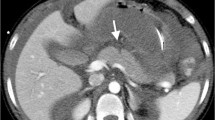Abstract
Blunt pancreatic trauma is an exceedingly rare but life-threatening injury with significant mortality. Computed tomography (CT) is commonly employed as the initial imaging modality in blunt trauma patients and affords a timely diagnosis of pancreatic trauma. The CT findings of pancreatic trauma can be broadly categorized as direct signs, such as a pancreatic laceration, which tend to be specific but lack sensitivity and indirect signs, such as peripancreatic fluid, which tend to be sensitive but lack specificity. In patients with equivocal CT findings or ongoing clinical suspicion of pancreatic trauma, magnetic resonance cholangiopancreatography (MRCP) may be employed for further evaluation. The integrity of the main pancreatic duct is of crucial importance, and though injury of the duct may be strongly suggested upon initial CT, MRCP provides clear delineation of the duct and any potential injuries. This article aims to review and illustrate the CT and magnetic resonance imaging findings of blunt pancreatic trauma and delineate the integration of these modalities into the appropriate imaging triage of severely injured blunt trauma patients.








Similar content being viewed by others
References
Cirillo RL Jr, Leonidas GK (2002) Detecting blunt pancreatic injuries. J Gastrointest Surg 6:587–589. doi:10.1016/S1091-255X(01) 00028-2
Gupta A, Stuhlfaut JW, Fleming KW, Lucey BS, Soto JA (2004) Blunt trauma of the pancreas and biliary tract: a multimodality imaging approach to diagnosis. Radiographics 24:1381–1395. doi:10.1148/rg.245045002
Jurkovich GJ (2000) The duodenum and pancreas. In: Mattox KL, Feliciano DV, Moore EE (eds) Trauma, 4th edn. McGraw-Hill, New York, NY, pp 735–762
Anderson SW, Soto JA (2009) Pancreatic duct evaluation: accuracy of portal venous phase 64 MDCT. Abdom Imaging 34:55–63. doi:10.1007/s00261-008-9396-4
Itoh S, Ikeda M, Ota T et al (2003) Assessment of the pancreatic and intrapancreatic bile ducts using 0.5-mm collimation and multiplanar reformatted images in multislice CT. Eur Radiol 13:277–285
Venkatesh SK, Chin Wan JM (2008) CT of blunt pancreatic trauma–a pictorial essay. Eur J Radiol 67:311–320. doi:10.1016/j.ejrad.2007.07.003
Bradley EL, Young PR, Chang MC et al (1998) Diagnosis and initial management of blunt pancreatic trauma: guidelines from a multiinstitutional review. Ann Surg 227:861–869. doi:10.1097/00000658-199806000-00009
Al-Ahmadi K, Ahmed N (2008) Outcomes after pancreatic trauma: experience at a single institution. Can J Surg 51:118–124
Salles A, Nino-Murcia M, Jeffrey RB Jr (2008) CT of pancreas: minimum intensity projections. Abdom Imaging 33:207–213. doi:10.1007/s00261-007-9212-6
Gong JS, Xu JM (2004) Role of curved planar reformations using multidetector spiral CT in diagnosis of pancreatic and peripancreatic diseases. World J Gastroenterol 10:1943–1947
Teh SH, Sheppard BC, Mullins RJ et al (2007) Diagnosis and management of blunt pancreatic ductal injury in the era of high-resolution computed axial tomography. Am J Surg 193:641–643. doi:10.1016/j.amjsurg.2006.12.024
Akhrass R, Kim K, Brandt C (1996) Computed tomography: an unreliable indicator of pancreatic trauma. Am Surg 62:647–651
Patel SV, Spencer JA, El-Hasani S, Sheridan MB (1998) Imaging of pancreatic trauma. Br J Radiol 71:985–990
Shanmuganathan K (2004) Multi-detector row CT imaging of blunt abdominal trauma. Semin Ultrasound CT MR 25:180–204. doi:10.1016/j.sult.2004.02.002
Ilahi O, Bochicchio GV, Scalea TM (2002) Efficacy of computed tomography in the diagnosis of pancreatic injury in adult blunt trauma patients: a single-institutional study. Am Surg 68:704–707
Wong YC, Wang LJ, Lin BC et al (1997) CT grading of blunt pancreatic injuries: prediction of ductal disruption and surgical correlation. J Comput Assist Tomogr 21:246–250. doi:10.1097/00004728-199703000-00014
Heitsch RC, Knutson CO, Fulton RL, Jones CE (1976) Delineation of critical factors in the treatment of pancreatic trauma. Surgery 80:523–529
Duchesne JC, Schmeig R, Islam S et al (2008) Selective nonoperative management of low-grade blunt pancreatic injury: are we there yet? J Trauma 65:49–53. doi:10.1097/TA.0b013e318176c00d
Brestas PS, Karakyklas D, Gardelis J et al (2006) Sequential CT evaluation of isolated non-penetrating pancreatic trauma. JOP 7:51–55
Wong YC, Wang LJ, Fang JF et al (2008) Multidetector-row computed tomography (CT) of blunt pancreatic injuries: can contrast-enhanced multiphasic CT detect pancreatic duct injuries? J Trauma 64:666–672. doi:10.1097/TA.0b013e31802c5ba0
Lane MJ, Mindelzun RE, Sandhu JS et al (1994) CT diagnosis of blunt pancreatic trauma: importance of detecting fluid between the pancreas and the splenic vein. AJR Am J Roentgenol 163:833–835
Chapman VM, Rhea JT, Sacknoff R, Novelline RA (2004) CT of nontraumatic abdominal fluid collections after initial fluid resuscitation of patients with major burns. AJR Am J Roentgenol 182:1493–1496
Nirula R, Velmahos GC, Demetriades D (1999) Magnetic resonance cholangiopancreatography pancreatic trauma: a new diagnostic modality? J Trauma 47(3):585–587. doi:10.1097/00005373-199909000-00031
Soto JA, Alvarez O, Munera F et al (2001) Traumatic disruption of the pancreatic duct: diagnosis with MR pancreatography. AJR Am J Roentgenol 176:175–178
Matos C, Winant C, Deviere J (2001) Magnetic resonance pancreatography. Abdom Imaging 26:243–253. doi:10.1007/s002610000166
Ragozzino A, Manfredi R, Scaglione M et al (2003) The use of MRCP in detection of pancreatic injuries after blunt trauma. Emerg Radiol 10:14–18
Gillams AR, Kurzawinski T, Lees WR (2006) Diagnosis of duct disruption and assessment of pancreatic leak with dynamic secretin-stimulated MR cholangiopancreatography. AJR Am J Roentgenol 186:499–506. doi:10.2214/AJR.04.1775
Timberlake GA (1997) Blunt pancreatic trauma: experience at a rural referral center. Am Surg 63:282–286
Liu KJ, Atten MJ, Lichtor T et al (2001) Serum amylase and lipase elevation is associated with intracranial events. Am Surg 67:215–219
Author information
Authors and Affiliations
Corresponding author
Rights and permissions
About this article
Cite this article
Rekhi, S., Anderson, S.W., Rhea, J.T. et al. Imaging of blunt pancreatic trauma. Emerg Radiol 17, 13–19 (2010). https://doi.org/10.1007/s10140-009-0811-0
Received:
Accepted:
Published:
Issue Date:
DOI: https://doi.org/10.1007/s10140-009-0811-0




